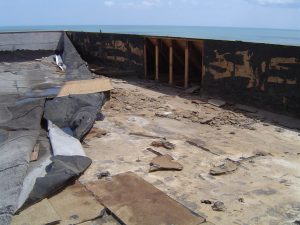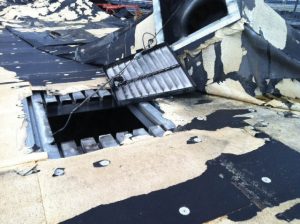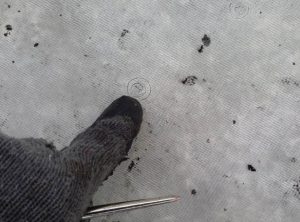— By Shawn Morrow —
Proactive practices to protect your retail/restaurant roof when severe weather strikes.
Severe weather events can be considered the Number 1 enemy to a commercial roof. Depending on where a building is located in the country, a roof can fall prey to snow and ice storms in the winter, high wind, hail and rainstorms in the spring and summer, and hurricanes in the fall.

Shawn Morrow, Simon Roofing
Unfortunately, severe weather events are on the rise due to global weather pattern changes. In fact, the EPA recently reported that scientific studies indicate that extreme weather events such as heat waves and large storms are likely to become more frequent or more intense. They also shared that average temperatures are on the rise with extreme highs and lows being more common. Annual precipitation is also increasing as is the number of intense single-day precipitation events.
The National Oceanic and Atmospheric Administration is still predicting an above-normal Atlantic hurricane season for 2022. The organization is predicting 14 to 20 named storms with winds of 39 mph or greater, of which 6 to 10 could become hurricanes (winds of 74 mph or greater). Of those, 3 to 5 could become major hurricanes, with winds of 111 mph or greater. And just because your restaurant or retail facility isn’t on the coast doesn’t mean you’re risk-free. Hurricane force winds can be felt as far as 150 miles inland.
 Simply sitting back and keeping your fingers crossed when severe weather is headed your way can be a catastrophic tactic. The combination of planning and preparedness is the smartest approach in helping your roof — and your building — endure all that Mother Nature has to offer.
Simply sitting back and keeping your fingers crossed when severe weather is headed your way can be a catastrophic tactic. The combination of planning and preparedness is the smartest approach in helping your roof — and your building — endure all that Mother Nature has to offer.
Preparing Your Retail/Restaurant Roof BEFORE Severe Weather Events
A comprehensive roof inspection, complete with documentation, will serve as a baseline for insurance companies:
- Photograph everything, including the full roof and defects.
- Identify roof type/system and date installed. If possible, include manufacturer of the roof system.
Preventative maintenance can help to minimize damage:
- Clean any debris, foreign objects or items that are not secured from roof.
- Make sure drains, gutters, etc., are clear and are moving water.
- Repair any minor defects.
- Check for loose flashing around perimeter, equipment, curbs and more.
- Make sure all equipment is secured, including HVAC units, grease traps, vents, bell fans, hatches and skylights. Make sure any satellite dishes are secured tightly.
– Utilize additional fasteners or straps if necessary.
- Trim bushes and trees away from facility.
Establish a good working relationship with a roofing contractor that can meet the needs and requirements of retail and restaurant facilities.
- Ask for the contractor to define the following prior to any severe weather:
– Emergency response labor rates
– Availability of crews
– Safety Record – Incident Rate
– Years in business
– State License if required
– Contractors Insurance certificate
– 24/7 contact information
- Review your current insurance policy with your broker.
Next Steps AFTER Severe Weather Strikes
Timely mitigation is key. Get the roof to watertight condition as quickly as possible.
- Temporary repairs will stop water from causing further damage and allow your business to get up and running as quickly as possible.
- Take detailed photos or ask your roofing provider to take photos of damage for insurance claims; thoroughly document all damage/defects.
Once temporary repairs are complete, slow down to identify all potential options. Before you make major investments in a long term solution, make sure you consider all factors:
- Research building codes. Make sure your roofing provider is well-versed in local codes and can meet/exceed these requirements.
- Conduct a thorough inspection, that includes, but is not limited to, an infrared scan. Wind damage can cause uplift and lead to wet insulation. If wet insulation is permeated through the roof, you may need to tear off and replace the entire roof. If wet insulation is only in a small area or not present, repair and restoration options may be possible to stop widespread leaks. Infrared scanning will help identify wet insulation.
- Determine if asbestos is present by using a certified hazardous materials inspection provider and remove if necessary. This company should have special certifications and trained technicians to handle such materials.
- Consider the individual needs of the building and type of business you are conducting below, including these factors:
– Climate
– Building type
– Longevity of the building
– Devastation of the storm — what will the area look like during the aftermath?
– Short term and long term goals: Are you planning to still be there in 20 years?
Weather Emergency Plan
 Severe weather events can cause significant damage to the roof on your retail/restaurant building. Before a significant weather event occurs, it’s vital to have a comprehensive severe weather emergency plan in writing.
Severe weather events can cause significant damage to the roof on your retail/restaurant building. Before a significant weather event occurs, it’s vital to have a comprehensive severe weather emergency plan in writing.
But that’s not enough. You need to make sure that it’s shared from the top down and understood by not only your team, but all employees. It also needs to be reviewed and refreshed on a regular basis to make sure all elements are still relevant.
Planning and preparedness are essential when trying to minimize severe weather damage to your building. Save crossing your fingers for when watching your favorite sports team.
SIDEBAR:
Hail Damage
 Hail damage is especially prevalent on roofs. According to a report from Insurance Information Institute, 6.2 million properties in the U.S. experienced one or more damaging hail events in 2020, with almost $14.2 billion in losses. Most states can experience hail, with the “hail alley” areas being Colorado, Nebraska and Wyoming northward through the Midwest, south toward the Gulf Coast and desert Southwest, and east toward Appalachia. In 2021, Texas led the list with the most reported hail events in the country.
Hail damage is especially prevalent on roofs. According to a report from Insurance Information Institute, 6.2 million properties in the U.S. experienced one or more damaging hail events in 2020, with almost $14.2 billion in losses. Most states can experience hail, with the “hail alley” areas being Colorado, Nebraska and Wyoming northward through the Midwest, south toward the Gulf Coast and desert Southwest, and east toward Appalachia. In 2021, Texas led the list with the most reported hail events in the country.
Generally speaking, commercial roofs may be damaged by hail. Hail events are trackable and recorded by the National Weather Service at www.weather.gov, so if you suspect hail damage, be sure to search for the hail event on the website.
Hail Damage Signs
- Dinged, dented or bent metal, either on top of the roof or on gutters, HVAC units, etc.
- Broken windows or skylights
- Displaced gravel
- Spiderwebbing
- Holes, cracks, fissures and punctures to your roof membrane
Left untreated, damage can lead to water intrusion and wet insulation.
— Shawn Morrow is the Gulf Coast territory manager for Simon Roofing. He is a life-long resident of New Orleans. Simon Roofing is a national commercial roofing provider with 68 service centers coast to coast.

